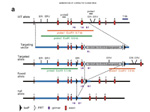Cttntm1.2Okab
Targeted Allele Detail
|
|
| Symbol: |
Cttntm1.2Okab |
| Name: |
cortactin; targeted mutation 1.2, Shigeo Okabe |
| MGI ID: |
MGI:4418949 |
| Gene: |
Cttn Location: Chr7:143989468-144024743 bp, - strand Genetic Position: Chr7, 88.84 cM
|
| Alliance: |
Cttntm1.2Okab page
|
|
| Germline Transmission: |
Earliest citation of germline transmission:
J:155986
|
| Parent Cell Line: |
J1 (ES Cell)
|
| Strain of Origin: |
129S4/SvJae
|
|
| Allele Type: |
|
Targeted (Null/knockout) |
| Mutations: |
|
Insertion, Intragenic deletion
|
| |
|
Mutation details: A single loxP site was introduced 0.5-kb downstream of Exon 4. A reporter fusion construct containing a FRT site, splice acceptor (derived from 0.6kb upstream of exon 6), the cDNA from exons 6-18, IRES, b-galactosidase-neo, polyA, FRT site and an additional loxP site were inserted within intron 5 by homologous recombination. The reporter construct and exon 5 were removed by flp- and cre- mediated recombination respectively. Western blotting showed absence of protein in fibroblasts.
(J:155986)
|
|
Generation of the Cttntm1.1Okab and Cttntm1.2Okab alleles |

|
|
View phenotypes and curated references for all genotypes (concatenated display).
|
| Mouse strains and cell lines
available from the International Mouse Strain Resource
(IMSR) |
| Carrying this Mutation: |
Mouse Strains: 0 strains available
Cell Lines: 0 lines available
|
| Carrying any Cttn Mutation: |
29 strains or lines available
|
|
| Original: |
J:155986 Tanaka S, et al., Generation of cortactin floxed mice and cellular analysis of motility in fibroblasts. Genesis. 2009 Sep;47(9):638-46 |
| All: |
1 reference(s) |
|
 Analysis Tools
Analysis Tools





